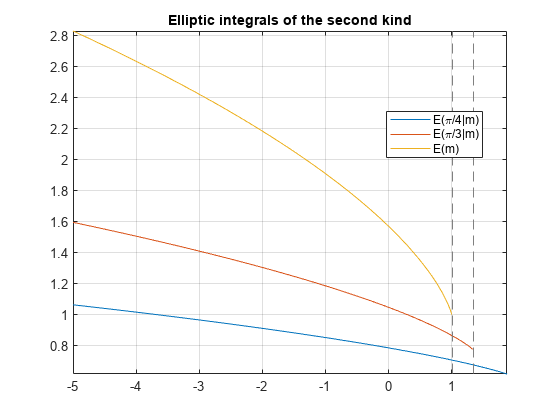ellipticE
Complete and incomplete elliptic integrals of the second kind
Description
ellipticE( returns the complete elliptic integral of the second
kind.m)
ellipticE( returns
the incomplete elliptic integral of the
second kind.phi,m)
Examples
Find Complete Elliptic Integrals of Second Kind
Compute the complete elliptic integrals of the second kind for these numbers. Because these numbers are not symbolic objects, you get floating-point results.
s = [ellipticE(-10.5), ellipticE(-pi/4),... ellipticE(0), ellipticE(1)]
s =
3.7096 1.8443 1.5708 1.0000Compute the complete elliptic integral of the second kind for the same numbers converted
to symbolic objects. For most symbolic (exact) numbers, ellipticE returns
unresolved symbolic calls.
s = [ellipticE(sym(-10.5)), ellipticE(sym(-pi/4)),... ellipticE(sym(0)), ellipticE(sym(1))]
s = [ ellipticE(-21/2), ellipticE(-pi/4), pi/2, 1]
Use vpa to approximate this result with
floating-point numbers:
vpa(s, 10)
ans = [ 3.70961391, 1.844349247, 1.570796327, 1.0]
Differentiate Elliptic Integrals of Second Kind
Differentiate these expressions involving elliptic integrals of the second kind.
ellipticK and ellipticF represent the complete and
incomplete elliptic integrals of the first kind, respectively.
syms m diff(ellipticE(pi/3, m)) diff(ellipticE(m^2), m, 2)
ans = ellipticE(pi/3, m)/(2*m) - ellipticF(pi/3, m)/(2*m) ans = 2*m*((ellipticE(m^2)/(2*m^2) -... ellipticK(m^2)/(2*m^2))/m - ellipticE(m^2)/m^3 +... ellipticK(m^2)/m^3 + (ellipticK(m^2)/m +... ellipticE(m^2)/(m*(m^2 - 1)))/(2*m^2)) +... ellipticE(m^2)/m^2 - ellipticK(m^2)/m^2
Elliptic Integral for Matrix Input
Call ellipticE for this symbolic matrix. When the input argument is a
matrix, ellipticE computes the complete elliptic integral of the second
kind for each element.
ellipticE(sym([1/3 1; 1/2 0]))
ans = [ ellipticE(1/3), 1] [ ellipticE(1/2), pi/2]
Plot Complete and Incomplete Elliptic Integrals of Second Kind
Plot the incomplete elliptic integrals ellipticE(phi,m) for phi = pi/4 and phi = pi/3. Also plot the complete elliptic integral ellipticE(m).
syms m fplot([ellipticE(pi/4,m) ellipticE(pi/3,m) ellipticE(m)]) title('Elliptic integrals of the second kind') legend('E(\pi/4|m)','E(\pi/3|m)','E(m)','Location','Best') grid on

Input Arguments
More About
Tips
ellipticEreturns floating-point results for numeric arguments that are not symbolic objects.For most symbolic (exact) numbers,
ellipticEreturns unresolved symbolic calls. You can approximate such results with floating-point numbers usingvpa.If
mis a vector or a matrix, thenellipticE(m)returns the complete elliptic integral of the second kind, evaluated for each element ofm.At least one input argument must be a scalar or both arguments must be vectors or matrices of the same size. If one input argument is a scalar and the other one is a vector or a matrix, then
ellipticEexpands the scalar into a vector or matrix of the same size as the other argument with all elements equal to that scalar.ellipticE(pi/2, m) = ellipticE(m).
Alternatives
You can use ellipke to compute elliptic integrals of the
first and second kinds in one function call.
References
[1] Milne-Thomson, L. M. “Elliptic Integrals.” Handbook of Mathematical Functions with Formulas, Graphs, and Mathematical Tables. (M. Abramowitz and I. A. Stegun, eds.). New York: Dover, 1972.
Version History
Introduced in R2013a
See Also
ellipke | ellipticCE | ellipticCK | ellipticCPi | ellipticF | ellipticK | ellipticPi | vpa